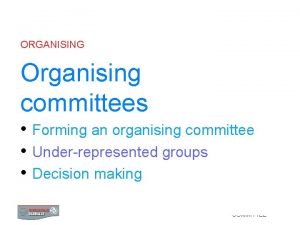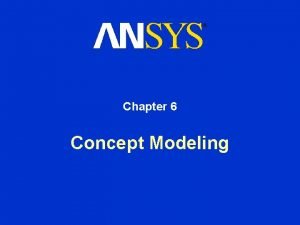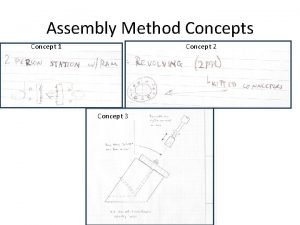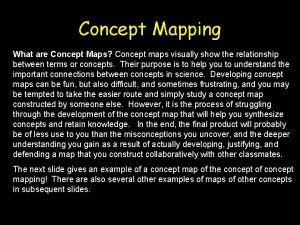ORGANISING Concept of Organising In the last chapter








































- Slides: 40

ORGANISING

Concept of Organising In the last chapter we discussed about planning, which making plans for achieving objectives. Planning is only successful when organizing function is done well by management. So , organising as a function of management is responsible for successful implementation of plans, to accomplish business objectives. Organising , which ensures that all physical and human resources required to achieve objectives are available , the enterprise is structured in a manner that it is able to adapt to the dynamic business environment.

Concept of Organising Lets learn organising in simple way, - suppose u have objective to achieve more than 90% marks in your board exam this year and to get admission in reputed college/university. So what have you done to to achieve your objective? I am sure you all must have prepared a plan for it. Plan may be like, to devote at least 5 hours in a week of self study to each subject.

Concept of Organising Your plan is perfect but for achieving your goal, you will require physical resources like all relevant books, a place where you can study with concentration and human resources like a teacher/mentor who will guide you to make short term goals, help you to prepare notes, answer questions, manage time etc. Did you realise what are you doing? Nothing but organising resources to achieve your objectives. All this is part of organising function of management.

MEANING OF ORGANISING ‘Organising translates plans into action’ by deciding who will perform a particular task, how and where it will be performed. ‘Organising is the process of defining and grouping the activities of the enterprise and establishing authority relationship among them’. ---- THEO HAIMMAN ‘To organize a business is to provide it with everything useful to its functioning: raw materials, machines and tools, capital and personnel’. – HENRI FAYOL

ORGANISING PROCESS

Identification & Division Of Work: – The total work to be done should be divided into specific jobs as according to predetermined plans. – Job = a set of related tasks that can be performed by an individual. It should have specific and definite tasks to be performed. As far as possible, it should define expected results along with the job. Division of work → specialization of efforts and skills + avoids duplication of work. Management must ensure that all the activities required to achieve organizational objectives are identified.


Departmentalization Grouping similar and related jobs into larger units called departments, divisions or sections and placing them under a department head. It facilitates specialization. The departments are linked together and are interdependent. Aims at achieving co-ordination and facilitate unity of action. Departmentation can be done on the basis of: • Functions: marketing, personnel, finance etc. • Products: Textiles, chemical, power division etc. • Territories: Western, northern, central, eastern etc.


Assignment Of Duties:

Assignment Of Duties: Define the work of different job positions and allocate work accordingly. Once departments are formed, the dept is placed under the charge of an individual. Jobs are assigned to an individual best suited to perform it. Qualifications, experience, ability and aptitudes of people should be matched with duties. E. g. activities of finance should be assigned to persons having qualifications and experience in finance e. g. C. A‘s

Establishing Reporting Relationships: Granting requisite authority to enable employees to perform the job satisfactorily. Superior subordinate relations between different people and job positions created, so that everybody knows from whom he is to take orders and to whom he can issue orders. Creates management hierarchy = a chain of command from the top manager to the individual at the lowest level. This helps in coordination.


Importance of Organizing Benefits of specialization: In organizing every individual is assigned apart of total work and not the whole task. This division of work into smaller units and repetitive performance leads to specialization. Thus organizing promotes specialization which in turn leads to efficient & speedy performance of tasks. Clarity in working relationship: It helps in creating well defined jobs and also clarifying the limits of authority and responsibility of each job. The superior-subordinate relationship is clearly defined in organizing. Effective Administration: It provides a clear description of jobs and related duties which helps to avoid confusion and duplication. Clarity in working relationships enables proper execution of work which results ineffective administration. Optimum utilization of resources: The proper assignment of jobs avoids overlapping/duplication of work. This helps in preventing confusion and minimizing the wastage of resources and efforts.

Importance of Organizing Adoption to Change: A properly designed organizational structure is flexible which facilitates adjustment to changes in workload caused by change in external environment related to technology, products, resources and markets. Development of Personnel: Sound organization encourages initiative and relative thinking on part of the employees. When managers delegate their authority, it reduces their workload so they can focus on more important issues related to growth & innovation. This also develops the subordinates’ ability and helps him to realize his full potential. Expansion and growth: It helps in growth & diversification of an enterprise by adding more job positions, departments, products lines, new geographical territories etc.

Meaning of Organizational Structure It seeks to establish relations among all the persons working in the organization. Under the organizational structure, various posts are created to perform different activities for the attainment of the objectives of the enterprise. Relations among persons working on different posts are determined. The structure provides a basis or framework for managers and other employers for performing their functions. The organization structure can be defined as the frame work within which managerial and operating tasks are performed.

Relation between Span of Management and Organization structure: Span of management refers to the number of subordinates that can be effectively managed by a superior. The Span of management to a large extent gives shape to the organization structure. This determines the levels of management in the structure. Arrow span of management results in tall structure whereas wider span of management results in flat structure.


Functional Structure: In functional structure activities are grouped and departments are created on the basis of specific functions to be performed. For example, all the jobs related to production are grouped under production department, sales departments etc. Suitability (1) Large organizations producing one line of product. (2) Organizations which require high degree of functional specialization with diversified activities.

Functional Structure:

Advantages of functional structure Specialization: Better decision of labour takes place which results in specialization of functions and its consequent benefits. Coordination is established: All the persons working within a departmental are specialists of their respective jobs. It makes the co-ordination easier at departmental level. Helps in increasing managerial efficiency: Managers of one department are performing same type of function again and again which makes them specialized and improves their efficiency. Minimizes cost: It leads to minimum duplication of effort which results in economies of scale and thus

Disadvantages of functional structure Ignorance of organizational objectives: Each departmental head works according to his own wishes. They always give more weight to their departmental objectives. Hence overall organizational objectives suffer. Difficulty in Inter-departmental Coordination: All departmental heads work as per their own wishes which leads to coordination within the department easier but it makes inter-departmental coordination difficult. Hurdle in complete development – because each employee specializes only in a small part of the whole job.

DIVISIONAL ORGANIZATION STRUCTURE Dividing the whole enterprise according to the major products to be manufactured (like metal, plastic, cosmetics etc. ) is known as divisional organization structure. Suitability: This structure is suitable in organizations producing multi product or different lines of products requiring product specialization. Also growing companies which intend to add more lines of products in future adopt this structure.

DIVISIONAL ORGANIZATION STRUCTURE

Advantages of Divisional organization structure Quick decision-making: Divisional manager can take any decision regarding his division independently which makes decisions quick and effective. Divisional results can be assessed: Division results (profit/loss) can be assessed easily. On this basis any unprofitable division can be closed. Growth and Expansion: It facilitates growth and expansion as new divisions can be added without disturbing existing departments.

Disadvantages of Divisional organization structure Conflicts among different divisions on allocation of resources. Duplicity of Functions: Entire set of functions is required for all divisions. It gives rise to duplicity of efforts among divisions & increases cost. Selfish Attitude: Every division tries to display better performance and sometimes even at the cost of other divisions. This shows their selfish attitude.

Delegation of Authority Meaning: It means the granting of authority to subordinates to operate within the prescribed limits. The manager who delegates authority holds his subordinates responsible for proper performance of the assigned tasks. To make sure that his subordinates perform all the works effectively and efficiently in expected manner the manager creates accountability.

Elements of Delegation Authority: The power of taking decisions in order to guide the activities of others. Authority is that power which influences the conduct of others. Responsibility: It is the obligation of a subordinate to properly perform the assigned duty. When a superior issues orders, it becomes the responsibility of the subordinate to carry it out. Accountability: When a superior assigns some work to a subordinate, he is answerable to his superior for its success or failure.

Principle of Absoluteness of Accountability: Authority can be delegated but responsibility/accountability cannot be delegated by a manager. The authority granted to a subordinate can be taken back and re-delegated to another person. The manager cannot escape from the responsibility for any default or mistake on the part of his subordinates. For example, If the chief executive asks marketing manager to achieve a sales target of sale of 100 units/day. The marketing manager delegates this task to deputy sales manager, who fails to achieve the target. Then marketing manager will be answerable for the work performance of his subordinates. Thus, accountability is always of the person who delegates authority.

Difference between Authority, Responsibility and Accountability Basis Authority Responsibility Accountability 1. Meaning Right to command • bligation to perform an assigned task. Accountability for the outcome of the assigned task. 2. Origin Arises from formal position. Arises from delegated authority. Arises from responsibility. 3. Flow Downwardfrom superior Upward- from to subordinate to superior. subordinate. Upward- from subordinate to superior. 4. Withdrawl Can be withdrawn Cannot be withdrawn anytime by once created. giving notice. Cannot be withdrawn once created.

Delegation of Authority

Importance of the Delegation of Authority Reduction of Executives’ work load: It reduces the work load of officers. They can thus utilize their time in more important and creative works instead of works of daily routine. Employee development: Employees get more opportunities to utilize their talent which allows them to develop those skills which will enable them to perform complex tasks. Quick and better decision are possible: The subordinate are granted sufficient authority so they need not to go to their superiors for taking decisions concerning the routine matters.

Importance of the Delegation of Authority High Morale of subordinates: Because of delegation of authority to the subordinates they get an opportunity to display their efficiency and capacity. Better coordination: The elements of delegation – authority, responsibility and accountability help to define the powers, duties and answer ability related to various job positions which results in developing and maintaining effective coordination.


Decentralization Decentralisation of authority means dispersal of authority to take decisions throughout the organization, upto the lower levels. It implies reservation of some authority with the top level management and transferring rest of the authority to the lower levels of the organization. This empowers lower levels to take decisions regarding problems faced by them without having to go to the upper levels. According to Allen, ‘ Decentralisation refers to systematic efforts to delegate to the lowest level, all authority except the one which can be exercised at central points. ‟

Centralization vs Decentralisation Centralization = authority retained at top level and Decentralization = Systematic delegation of authority at all levels and in all departments of a firm. Firm needs to balance the two. In case of a decentralized firm, Top level retains authority for: Policies and decisions w. r. t the whole firm Overall control and coordination Middle and lower levels have authority to take decisions w. r. t tasks allocated to them

Centralization and Decentralization Centralization and Decentralization-represents the pattern of authority among managers at different levels. Centralization of authority means concentration of power of decision making in a few hands. In such an organization very little authority is delegated to managers at middle and lower levels. No organization can be completely centralized or decentralized. They exist together and there is a need for a balance between the two. As the organization grows in size, there is tendency to move towards decentralization. Thus, every organization is characterized by both.

Importance of Decentralization Develops initiative amongst subordinates: It helps to promote confidence because the subordinates are given freedom to take their own decisions. Quick and better decisions: The burden of managerial decisions does not lie in the hands of few individuals but gets divided among various persons which helps them to take better and quick decisions. Relieves the top executives from excess workload: The daily managerial works are assigned to the subordinates which leaves enough time with the superiors which they can utilize in developing new strategies. Managerial Development: It means giving authority to the subordinates up to the lower level to take decisions regarding their work. In this way the opportunity to take decisions helps in the development of the organization. Better Control: It makes it possible to evaluate performance at each level which results in complete control over all the activities.

Difference between – Delegation and Decentralization Basis Delegation Decentralization 1. Nature It is a compulsory act. It is an optional policy. 2. Freedom of action Less freedom to take decisions due to more control by the superiors. More freedom of action due to less control by the top management. 3. Status It is the result of policy It is a process of sharing tasks decisions taken by top and authority. management. 4. Scope Narrow- as it is confined to a superior and his immediate and subordinate. Wide- It includes extension of delegation to all the levels of management. To reduce the burden of To increase the role and the autonomy of lower level 5. Purpose
 Difference between accountability and responsibility
Difference between accountability and responsibility Schedule project management
Schedule project management Organising principles
Organising principles Function of management
Function of management Self organising map
Self organising map Staffing and controlling
Staffing and controlling Organising a seminar
Organising a seminar Planning and organizing in the workplace
Planning and organizing in the workplace Hát kết hợp bộ gõ cơ thể
Hát kết hợp bộ gõ cơ thể Ng-html
Ng-html Bổ thể
Bổ thể Tỉ lệ cơ thể trẻ em
Tỉ lệ cơ thể trẻ em Gấu đi như thế nào
Gấu đi như thế nào Chụp tư thế worms-breton
Chụp tư thế worms-breton Bài hát chúa yêu trần thế alleluia
Bài hát chúa yêu trần thế alleluia Môn thể thao bắt đầu bằng từ đua
Môn thể thao bắt đầu bằng từ đua Thế nào là hệ số cao nhất
Thế nào là hệ số cao nhất Các châu lục và đại dương trên thế giới
Các châu lục và đại dương trên thế giới Cong thức tính động năng
Cong thức tính động năng Trời xanh đây là của chúng ta thể thơ
Trời xanh đây là của chúng ta thể thơ Mật thư anh em như thể tay chân
Mật thư anh em như thể tay chân 101012 bằng
101012 bằng độ dài liên kết
độ dài liên kết Các châu lục và đại dương trên thế giới
Các châu lục và đại dương trên thế giới Thơ thất ngôn tứ tuyệt đường luật
Thơ thất ngôn tứ tuyệt đường luật Quá trình desamine hóa có thể tạo ra
Quá trình desamine hóa có thể tạo ra Một số thể thơ truyền thống
Một số thể thơ truyền thống Cái miệng xinh xinh thế chỉ nói điều hay thôi
Cái miệng xinh xinh thế chỉ nói điều hay thôi Vẽ hình chiếu vuông góc của vật thể sau
Vẽ hình chiếu vuông góc của vật thể sau Nguyên nhân của sự mỏi cơ sinh 8
Nguyên nhân của sự mỏi cơ sinh 8 đặc điểm cơ thể của người tối cổ
đặc điểm cơ thể của người tối cổ Giọng cùng tên là
Giọng cùng tên là Vẽ hình chiếu đứng bằng cạnh của vật thể
Vẽ hình chiếu đứng bằng cạnh của vật thể Tia chieu sa te
Tia chieu sa te Thẻ vin
Thẻ vin đại từ thay thế
đại từ thay thế điện thế nghỉ
điện thế nghỉ Tư thế ngồi viết
Tư thế ngồi viết Diễn thế sinh thái là
Diễn thế sinh thái là Dạng đột biến một nhiễm là
Dạng đột biến một nhiễm là Số nguyên là gì
Số nguyên là gì
































































